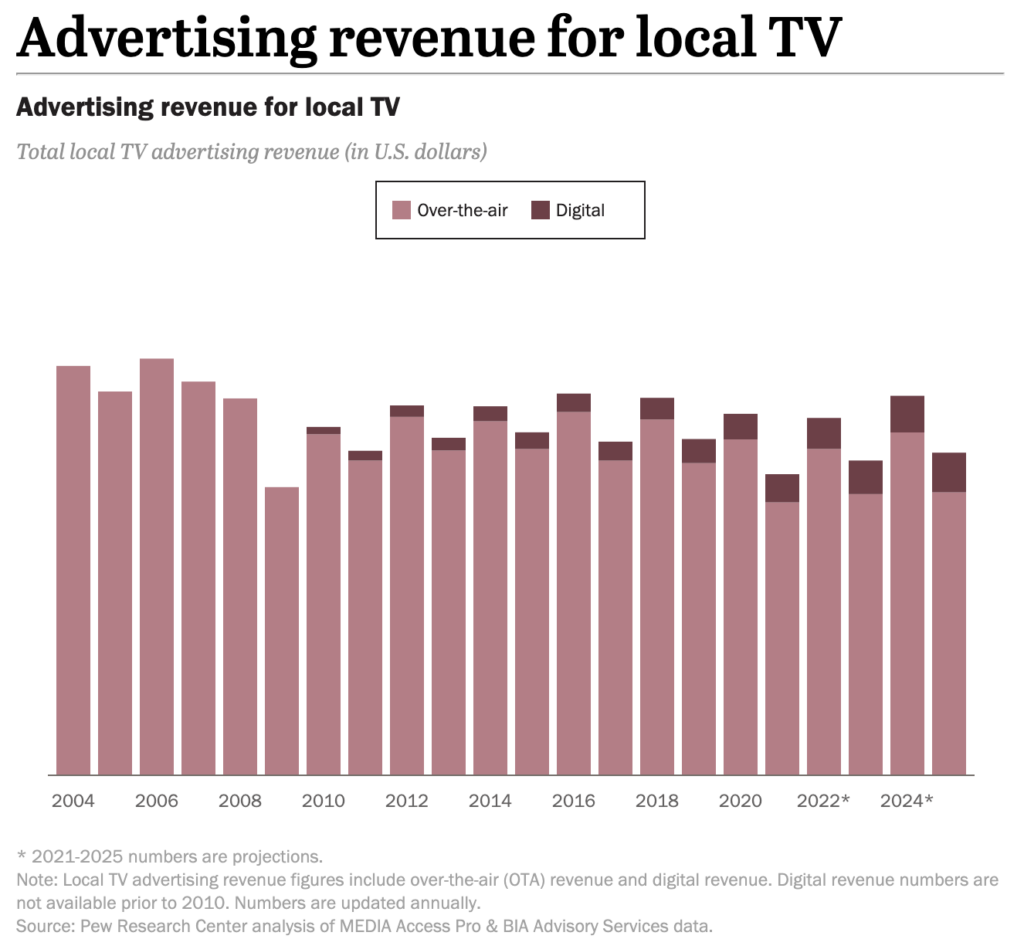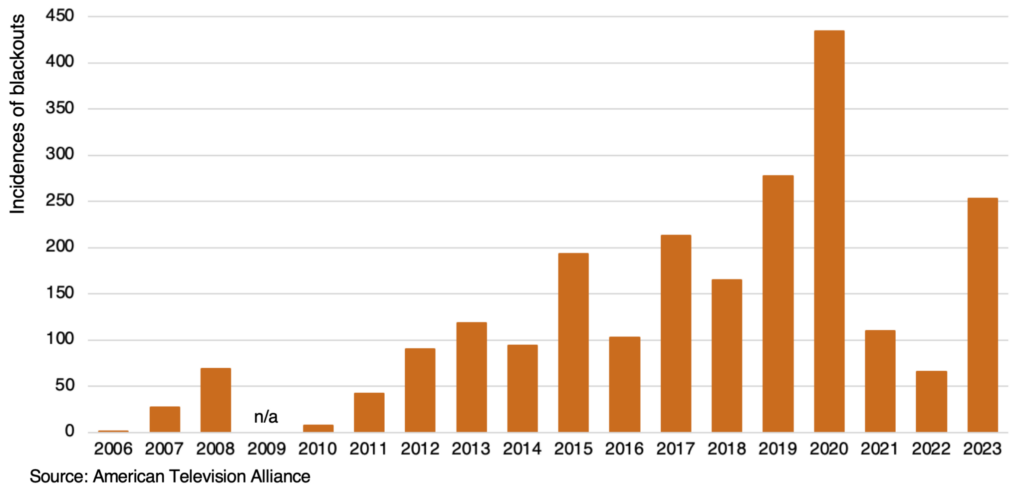
Cable and satellite programming blackouts often generate significant headlines. While the share of the population affected by blackouts may be small—bordering on minuscule—most consumers don’t like the idea of programming blackouts and balk at the idea of paying for TV programming they can’t access.
Enter the Federal Communications Commission (FCC) with a bold proposal to reduce the likelihood of programming blackouts. The proposed rules would require cable and satellite providers to give rebates to customers when there’s a blackout due to failed retransmission agreements with broadcast stations, networks, and channel-group owners.
Given the history of retransmission and the current regulatory and competitive environment, the FCC’s proposal looks to be a fool’s errand that may end up doing more harm than good.
Imagine it’s the late 1940s or early 1950s and you live in a small or mid-sized town. There are miles of hills and valleys separating your town from the major metropolis with a television station, so you can’t pick up the signal.
One day, the local radio station owner comes up with an idea. He’ll set up a big antenna on top of one of the tallest buildings in town to get the TV signals from the big city. Then, he’ll run a cable from that antenna down into town, where he can run separate cables to households and their TVs. The households will pay a set-up fee and a monthly charge to cover the entrepreneur’s costs.
That’s the basic parable of how community-antenna television—or CATV, now known as cable TV—came to be. And it was a game changer for small and rural communities that never before enjoyed big-city TV signals.
At first blush, this would seem to be what is known as a Pareto improvement—one where someone is made better off, but no one is made worse off. Households got previously unavailable TV programming, the entrepreneur turned a profit, and the big-city TV station expanded its viewership, which offered opportunities for greater advertising revenues.
These benefits were amplified by the FCC’s “freeze” on issuing new television licenses between 1948 and 1952, when demand for TV was increasing. CATV was a market solution to a regulatory hiccup.
Once the FCC began issuing licenses again, conflicts around CATV arose. Smaller and more rural areas that were previously unserved by broadcast received licenses for TV stations. These stations rightly saw CATV providing “out of market” signals as competition for viewers and advertising, as discussed in Carter Mountain Transmission Corp. v. FCC (D.C. Cir. 1963):
If [CATV] appellant’s application were granted, the service which could be offered by the [CATV] Western systems would be improved. Western could offer subscribers a better picture. It is probable that new subscribers would be attracted and that many, if not most, of the subscribers would view only the stations on the CATV cable. The conclusion is certainly warranted on these facts that the local [broadcast] station would find it increasingly difficult to sell advertising, its best source of income, in the light of this potential shift in listener-viewer reception, and its survival would be seriously jeopardized.
Under the Radio Act of 1927 and the Communications Act of 1934, radio stations were prohibited from rebroadcasting another station’s programming without the originating station’s consent. With an eye toward these regulations, TV broadcasters expected the same rules would apply to cable retransmission of broadcast programming. That expectation was misguided.
According to Jack Goodman, in 1959, the FCC decided that the Communications Act did not require cable providers to obtain consent before retransmitting over-the-air TV signals. In addition, subsequent court decisions in the 1960s and 1970s held that cable retransmission did not constitute a “performance” under the Copyright Act and were therefore not required to obtain consent from or pay royalties to copyright holders.
In this regulatory landscape, over-the-air broadcasters believed (perhaps correctly) that cable providers were free-riding on broadcasters’ investments in programming. To say that a lot happened between then and now among Congress, the FCC, and the courts would be an understatement. But that interlude is a story for another day.
Fast forward to the Cable Act of 1992. Under the Cable Act, each cable operator with 12 or more channels must carry the signals of local commercial television stations and qualified low-power broadcasting stations. Broadcasters have two options to exercise their rights under this provision:
- Require the cable operator to carry the broadcaster’s signal at no cost to the cable provider (known as must carry); or
- Negotiate retransmission consent with cable operators for carriage fees that the cable providers could refuse.
It’s important to note that the choice is up to the broadcaster, not the cable operator. The broadcaster could either exercise must carry or negotiate retransmission consent. Under must carry, the broadcaster is guaranteed carriage, but will not receive any fees or royalties. In negotiating retransmission consent, the broadcaster can receive carriage fees, but also runs the risk that the cable operator refuses the deal and drops the broadcaster from the cable operator’s channel lineup.
In the early years of the Cable Act’s framework, Charles Lubinsky reports that 80% of commercial TV stations and 90% of network-television affiliates chose retransmission consent over must carry. Interestingly, most of these agreements did not involve cash payments. Instead, the broadcasters negotiated for carriage of new broadcast services, according to Lubinsky:
Fox leveraged the introduction of fX; ABC leveraged ESPN2; NBC leveraged America’s Talking and renewals for CNBC; and some local stations leveraged a new channel, a regional news station, local news updates on cable news stations, or other specialty stations.
Jeffrey Eisenach notes that the first “significant” retransmission agreement to involve monetary compensation from a cable provider to a broadcaster was in 2005. By 2008, retransmission fees totaled $500 million, according to Variety.
It was around this time that networks began imposing “reverse transmission compensation” on their affiliates. Previously, networks paid local affiliates for airtime to run network advertisements during their programming. The new arrangement reversed the flow of compensation such that affiliates were expected to compensate the networks. The 2011 Variety article explains:
Station owners also face increased pressure to secure top fees for their retrans rights because their Big Four network partners now demand that affiliate stations fork over a portion of their retrans windfall to help them pay for pricey franchises like the NFL, “American Idol” and high-end scripted series.
It was also around this time that local-TV advertising revenues began to stagnate and shrink, as shown in the figure below. Higher retransmission fees were seen as a way to offset reduced ad revenues. By 2020, S&P Global reported that annual retransmission fees were approximately $12 billion.

With the wide range of programming and delivery options, it’s probably unwise to generalize who has the greater bargaining power in the current system. But if one had to choose, it seems that networks and, to a lesser extent, local broadcasters are in a slightly superior position. They have the right to choose must carry or retransmission and, in some cases, have alternative outlets (such as streaming) to distribute their programming.
I say slightly superior, because if the decks were firmly stacked in their favor, there would be fewer retransmission disputes. As many have noted, retransmission disputes that resulted in programming blackouts increased during the 2010s, peaking in 2020, as shown in the figure below.

As noted up top, in a step toward reducing the number of blackouts, the FCC recently proposed rules requiring cable and direct-broadcast satellite providers to give rebates to subscribers when they are deprived of programming during blackouts associated with retransmission-consent disputes.
At first glance, this may seem like a fair proposition. Consumers are merely bystanders in the dispute and they should not be on the hook to pay for programming they can’t access.
But like most issues in law & economics, the issue is more complex than simply consumer protection. If we believe that consumers are bystanders and that they are harmed by blackouts, then who is to blame for the blackouts? Or, in law & economics lingo, who is the least-cost avoider? This is an important question because it can be argued that the party in the better position to avoid the blackout should bear more of the cost of the blackout.
So who is responsible for programming blackouts?
It turns out that there is no good answer. Eun-A Park, Rob Frieden, and Krishna Jayakar use a database of nearly 400 retransmission agreements executed between 2011 and 2018 to evaluate the factors most likely to explain blackouts.
One factor is perhaps the most obvious—we’re seeing more blackouts because more stations have eschewed must carry in favor of negotiating retransmission consent. Park and her co-authors note that, even if the likelihood of a negotiation leading to a blackout is stable over time, the increased number of negotiations would be associated with an increase in the number of blackouts.
But Park et al.’s data don’t support this hypothesis: There’s no significant relationship between the number of “deals” and the number of blackouts. Instead, Park and her colleagues identify three factors that are associated with more blackouts and longer blackouts:
- Cable, satellite, and other multichannel video programming distributors (MVPDs) with larger customer bases are associated with more and longer blackouts;
- Multi-station broadcaster groups with network affiliations are associated with more, but shorter, blackouts; and
- The NFL season (e.g., “must see” real-time programming) has no significant relationship with blackout frequency. When blackouts do occur during the season, however, they are significantly shorter.
To be blunt, everyone’s to blame, so no one’s to blame. Ultimately, Park et al. conclude, “the statistical analysis is not able to identify the parties or the tactics responsible for blackouts.” Based on this research, it’s not clear which party is the least-cost avoider of blackouts.
Which takes us back to the FCC’s proposal to mandate cable and satellite providers rebate consumers for lost programming during blackouts. The proposed rules would put a thumb on the scale to favor broadcasters over cable and satellite providers. The rebates clearly impose a monetary cost, but there’s also a non-monetary cost.
If the rules are approved, the FCC would be tacitly indicating that the federal government believes cable and satellite providers are liable for programming disruptions resulting from retransmission disputes. This suggestion may drive more consumers to “cut the cord” and switch to an alternative MVPD, such as a streaming service.
The rules may backfire on programming providers. If cable and satellite providers are liable for the costs of the blackout, then they have incentives—and a rationale—for offering lower compensation to broadcasters to offset these costs. This could be especially harmful to smaller or local programmers who rely on retransmission fees to fill in the gap left by declining advertising revenue.
Finally, consumers may cheer the idea of receiving a rebate for missed programming during a blackout. Practically speaking, however, the rebates they receive would almost certainly be less than $10 and likely less than $5. The costs of imposing, monitoring, and enforcing the FCC’s proposed rules may end up being significantly larger than any consumer benefits.
The current retransmission regulations are imperfect, but perfection can never be achieved in such a complex and dynamic environment. The current rules have worked for three decades, and there’s no indication that the world has shifted in a way that demands the radical shakeup the FCC is proposing.




